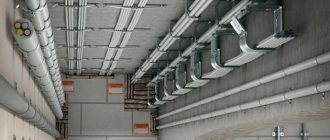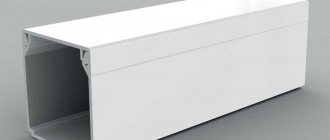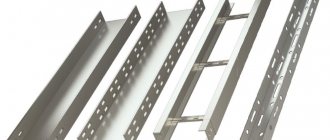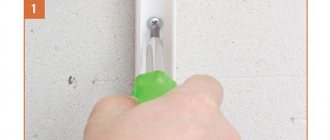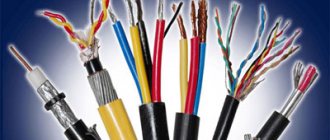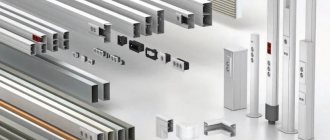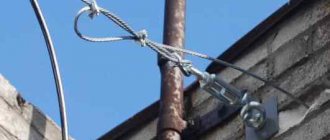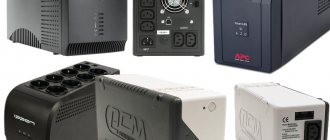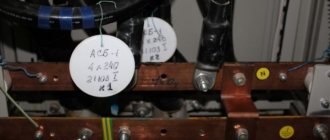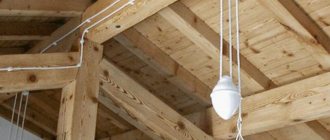In what cases is corrugation needed when laying cables?
Corrugation is a special pipe of a special shape, which is characterized by increased flexibility and can be made of polymer PVC plastic, polypropylene, polyethylene, polyamides or metal.
The main function of the corrugation is to provide protection for electrical wiring in a private house, apartment, or any other place where cable and wire products are installed from mechanical influences, the influence of precipitation, moisture, UV radiation and other negative factors. Having the ability to self-extinguish, the corrugation takes the first “blow” if the power line ignites.
Let's consider situations where the use of corrugated pipes is strictly regulated by regulations and is simply rational:
- installation of exposed electrical wiring indoors on non-flammable surfaces (concrete, brick, etc.). To lay cables on wooden planes, you will need a special substrate made of a material that does not ignite, or ordinary metal corrugation;
- laying cables in a hidden way in rooms, for example, in a concrete pour, is recommended to be supplemented with corrugated protection;
- installation of external electrical routes, including overhead ones. Important: you should choose a corrugated pipe that is not afraid of UV rays;
- laying unarmored cables in the ground. For these purposes, you will need stainless metal or HDPE corrugation;
- installation of electrical routes in areas with a high probability of causing damage to cable products;
- creation of moving parts of an electrical circuit;
- planning to replace the cable line in the future (to simplify installation, the corrugation can be taken a larger size).
Causes of breakdowns and combustion
The corrugation fails earlier than other parts. Stones, hummocks, curbs, etc. can catch the corrugation and tear it.
In addition to external influences, the corrugation is damaged due to strong engine vibration. The internal combustion engine begins to vibrate strongly as a result of friction (when one cylinder does not work) or the engine mount is loosened and it has an increased amplitude during operation. Due to strong vibration, a large tensile force acts on the corrugation.
In addition to mechanical influences, the corrugation is subject to physical and chemical influences. The design of the car also has a catalyst that monitors exhaust gases. If the catalyst is clogged, hot CO2 gases begin to accumulate and create holes in the corrugation.
Read also: I can’t behave seriously at 20
If the corrugation braid is damaged, the entire corrugation should be replaced. The muffler corrugation is a disposable part, a consumable item.
The corrugation material for the muffler is high-alloy stainless steel.
Standards and rules for laying cables in corrugated cables
The requirements of state regulatory documents do not directly indicate the need to lay electrical cables in corrugation. However, from some standards one can draw clear conclusions about the use of corrugated pipes. For example:
- in table 2.1.3 PUE
(Fig. 1) it is recommended to install unprotected and protected cable and wire products in pipes made of difficult/non-combustible materials;
Fig.1
— clause 7.1.37 PUE
indicates that electrical wiring in the premises must be replaceable. It is easier to do this if the method of pulling the cable in a corrugation is used, because the procedure for replacing an electrical line that is laid in a groove or embedded is very labor-intensive;
— clause 3.58 SNiP 3.05.06-85
obliges to take measures to protect cable lines from mechanical damage.
Malfunctions of this exhaust system unit
There are several signs by which you can first say that the corrugation has burned out or torn. Extraneous noise, such as a sharp and deafening sound under the hood when the internal combustion engine is running, is a common sign of a malfunction of the corrugation.
If the corrugation is torn, the sound of the running motor will be very loud, and it will immediately become clear that the corrugation is full of holes.
In addition to noise, a sign may be exhaust gases inside the car. But, if there is no noise, then the corrugation was damaged slightly, for example, when the catalyst was clogged, gases accumulated and they made a hole in the corrugation.
In all cases, the corrugation must be replaced.
Features and nuances of installing corrugated cables in the ground
Installation of cable and wire products in corrugated structures in the ground does not contradict the requirements of the PUE and profile SNiPs. It is important to choose the right material and diameter of the corrugated pipe, as well as take into account all the nuances of this part of the electrical installation work. Below is a list of features to consider:
- You should not use corrugation made of ordinary metal. It will quickly become unusable under the influence of corrosive forces (moisture, chemical compounds);
- Polymer PVC corrugation is a possible, but not ideal option. This material does not withstand temperature changes well enough, it can become brittle and begin to “crumble”;
- Corrugated HDPE is the best choice. Low-density polyethylene copes well with all the “challenges” of underground cable laying;
- it is necessary to take care of special protective cases that will be placed over the corrugation in rocky areas of the cable route, in areas with an increased likelihood of soil pushing and disruption of the integrity of the power line (roads and paths, near trees, in shallow trenches, near other pipelines). The cases are made from asbestos-cement pipes or modern plastic materials, including detachable ones in the form of a pair of half-cylinders;
- when laying the corrugation together with the cable, you must not pull it; there should be a slight slack or even a wavy laying;
- We must not forget about grounding the armor of protected cables and stretching the signal tape.
How to conduct electrical wiring under a cassette structure yourself
Unimpeded access to the rough part is the main advantage that distinguishes this option from others. Therefore, there is no need to move the boxes outside the structure. Decorative trim is often used to hide everything.
The pipes are fixed to the base with brackets or clamps if the open option is selected.
It is important to adhere to the following rules when talking about a closed version.
- For metal or reinforced concrete bases, preference is given to metal, corrugated pipes.
- If the ceiling is made of wood, then wooden products are more suitable.
Hidden and open laying of wires in a corrugated pipe
Hidden electrical wiring in walls has its advantages, for example from an aesthetic point of view. In addition, the conductors are cooled better.
The disadvantages of this type of installation of power lines traditionally include:
- high labor intensity; — a large amount of construction waste; — increased likelihood of subsequent damage to the wires, for example, with a hammer drill; — a problem with installing hidden power lines in wooden buildings; — difficulty or impossibility of replacing electrical wires.
These problems are partially solved by pulling the cable into a corrugated cable and laying the pipe in prepared grooves or monolithic concrete.
It is easier to install open wiring in a corrugated pipe by making bends to lamps, sockets and switches. Flexible corrugation is excellent for laying even on uneven walls. The corrugated pipe is secured with special clips or ties.
Rules for installing corrugated cables in walls and ceilings
When laying corrugated cables along wall or ceiling surfaces, you must follow simple rules:
- cable power lines must be mounted in a horizontal or vertical plane;
- Mutual intersections of power lines should be avoided;
- power supply to switches is usually supplied from above, and to sockets from below;
- clips for mounting corrugations are secured using special anchors, screws or dowel nails;
- the distance between the corrugated pipe fastenings should not exceed 40 cm, otherwise the structure may sag;
- the joints of corrugated sections are formed by connecting couplings;
- the inter-wall passage of the corrugated route is made through a special sleeve and can be sealed;
- The rotation of the power line placed in a corrugated pipe is carried out to a radius the value of which is higher than permissible for the corresponding brand of cable product. It is important to remember that bends make future cable replacement more difficult;
- The corrugation must be secured to a suspended ceiling only on a concrete base.
How practical is ceiling wiring? Are safety rules violated in this case?
The use of ceiling light remains a necessity, despite the fact that many sources of lighting for walls have appeared. Air conditioners and fans are also devices located under the ceiling. For proper operation it is necessary to ensure uninterrupted power supply.
Wiring in the ceiling: pros and cons
There are several situations when such installation remains the only solution that can solve the problem:
- During subsequent installation of suspended ceilings made of plasterboard.
The corrugations and cables running along the top will be hidden behind the suspended ceiling. Drywall does not have to be used over the entire area. Let us assume that such a scheme is used in some areas.
- The room has already been filled with ready-made screed, which satisfies the characteristics.
There is no point in re-flooding the floor or ceiling if the quality of the surface is initially at the required level.
- There is no desire to change the floor covering that is already installed.
The main disadvantage is that the height of the room is reduced when using suspended ceilings. But this method has many more positive aspects:
- Easy distribution of components throughout the room.
- Trouble-free maintenance, replacement of parts if necessary. . You don’t even need to remember the location details.
- Simplification of further connection of lighting devices.
Many people prefer this method.
Basic rules for installing wiring in the ceiling
Electrical installation is carried out only on the basis of a pre-drawn plan, divided into parts and combined into one project.
When preparing papers, perform the following steps one by one:
- They determine the place from where electricity is supplied to the local area.
- Points where electricity is consumed are identified.
- Select an installation location for the protection components.
- Draw up diagrams for laying cables between entry points and consumers. The components from the previous paragraph are taken into account.
At the preliminary stage, you need to choose the method of work that will be optimal. The brand and cross-section of the cable are selected from special tables.
The installation method itself can be hidden or external.
The following additional recommendations help to avoid mistakes during work:
- It is advisable to lay electrical wiring in special protective corrugations. If this requirement is not met, there is a high probability of short circuits.
- Electrical appliances in the apartment are prohibited from being connected to one protection device. This is a bad option for further operation, even if the load does not exceed the standards. The appliances will turn off simultaneously when a short circuit occurs.
- Only the phase wire is broken by all switches. Otherwise, even the procedure for replacing light bulbs ends with an electric shock.
- It is unacceptable for the wires to touch or intersect each other.
- It is important to choose correctly not only the main type of wires, but also the cross-section.
- Special electrical boxes are used in bathrooms and kitchens.
- The cables are laid so that further stages of work do not cause problems.
Tree
Cables under such circumstances are pulled through steel pipes. Then fixing the products does not cause any trouble. The diameter should be such that the wiring fits easily inside.
For distribution pipes, it is important to use materials that are resistant to fire. Metal becomes the best choice for any situation. A layer of insulators is placed on the inner sides of such products, which will prevent the box and the current carrier from coming into contact with each other.
The work is carried out by performing the following actions:
- The drawing is transferred to the surface from a paper drawing. Cable installation lines are marked as accurately as possible.
- Next, distribution boxes are installed.
- The tubes are cut until the length is sufficient. At the next stage, these structures are fixed to the base on the ceiling.
- The individual parts of the pipes are connected, the standard option is welding.
- Cables are laid through pipes using pulling.
- Then they are discharged into the distribution box. The main thing is to leave the ends free, at least 20 cm.
- All wires are connected. The structure is wrapped with electrical tape and fixed.
- Afterwards, a functional check is allowed.
Concrete
In this case, cutting grooves. A special cutting tool equipped with diamond discs is used to help process the stone. Slotting types of devices (hammer, impact drill) are also needed, but only for hard-to-reach surfaces. The wider the groove, the better.
- Compared to the thickness of cables without protection, the depth of the groove is 2-3 times greater. Let us assume that the diameter of the protective shell is ½ larger.
- Cable laying is free. There is no tension.
- It is easy to check the depth indicator using a spatula attached to the wall.
- The groove section is covered only after the wiring is finally secured to the section. And on each side there is 1.5 meters in reserve.
Drywall
Restricted access to the base base is the main feature of ceilings made from this particular material. It is important to think in advance about where the points for prevention and inspection will be. Taking into account the type of base floor, the installation method is selected.
With a suspended ceiling made of plasterboard, the rack systems are successfully hidden inside. Therefore, open installation is allowed. The main thing is that all the wires in this case are located outside the structure.
Stretch ceiling
The stages of work are the same as in the case of drywall. Create a surface, subsequent access to which is limited. Not forgetting that there must be sufficient distance between the fixed corrugation and the ceiling. Otherwise, the corrugated surface of the structure installed on the ceiling opens to the eye.
Pass-through and distribution boxes are located outside the structure.
How to conduct electrical wiring under a cassette structure yourself
Unimpeded access to the rough part is the main advantage that distinguishes this option from others. Therefore, there is no need to move the boxes outside the structure. Decorative trim is often used to hide everything.
The pipes are fixed to the base with brackets or clamps if the open option is selected.
It is important to adhere to the following rules when talking about a closed version.
- For metal or reinforced concrete bases, preference is given to metal, corrugated pipes.
- If the ceiling is made of wood, then wooden products are more suitable.
Electrically conductive panels
Such ceilings consist of slabs filled with polyurethane foam. The plates themselves that conduct current are mounted in it. Up to 5 plates can be installed on one connector, the total power in this case will be up to 1.5 kW.
The following parameters are selected by the owner depending on the characteristics of the room:
- Transformer installation location. Determined by the technical characteristics of the device.
- Cable section.
- Method, laying method.
Tips and tricks
When drawing up a diagram, it is important to take into account where the main elements are installed, including distribution boxes and sockets, switches.
As for wires, it is recommended to choose the variety designated as VVGng.
Suitable even for those who do their own work, even in wooden houses.
What is recommended to pay attention to?
The use of suspended ceilings will solve many problems at the same time.
- There is no need to level the surface.
- Maintaining an attractive appearance.
- Easy dilution of components using a separate method.
But problems often arise. Especially when the wiring requires maintenance and was initially done incorrectly.
What problems do you encounter most often?
Often they encounter incorrect placement of the mounting molding. Installers do not pay attention to the fact that the junction box intersects with the mounting profile. Such errors are considered gross violations of standard rules.
The installers are doing the work even though they don't have all the equipment in stock. For example, there is no detector. There is a high risk of damaging hidden wiring if you do not check in advance for invisible elements inside the structure.
There are options when installation is carried out without the use of standard corrugated pipes. This option is only permissible when installing low-voltage systems to which a step-down transformer is connected. Where the voltage is up to 24 Volts. In other situations, you cannot do without corrugation during installation.
Lamps are the main consumers of electricity, which are connected to the ceiling, and wiring installation is organized for them. PVC coatings require less powerful devices. The film will melt if the indicator does not meet the standards.
LED lamps are the best choice for owners of suspended ceilings. They do not require special skills during installation and are not capable of melting the canvas. But the tension remains the same as in other situations.
There is no universal answer to the question of which installation option is better. You should not initially concentrate on only one option and ignore others. The choice is made depending on the material of the ceiling base. Each option has negative and positive sides; you need to understand which characteristics are preferable for a particular consumer.
